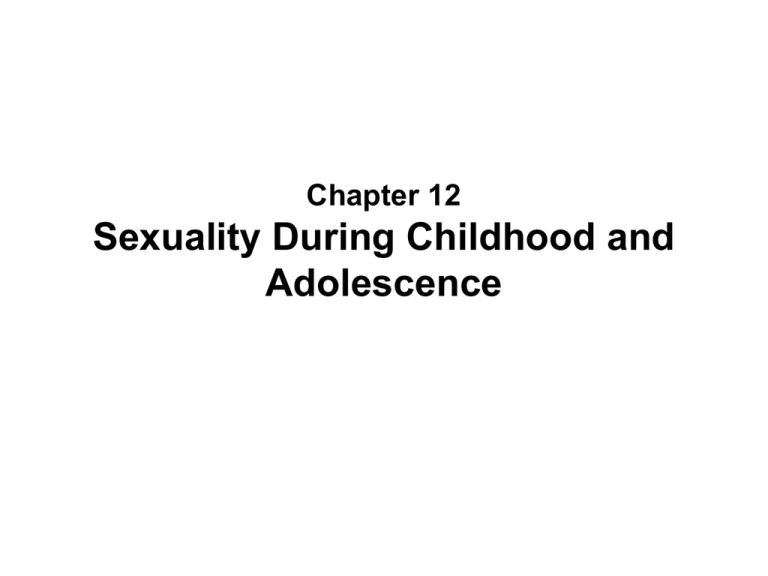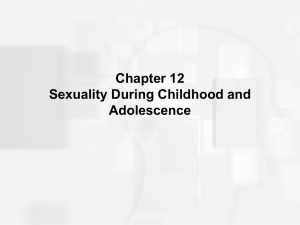Chapter 6 Sexual Arousal and Response
advertisement

Chapter 12 Sexuality During Childhood and Adolescence Infant and Childhood Sexuality • Capacity for sexual response present at birth • Infants engage in self-pleasuring activity • Unable to differentiate sexual from sensual pleasure • Sexual behavior is a normal part of development Childhood Sexuality • Normative behavior not well studied • Common behaviors at varying ages – – – – – 2 - 3 years: masturbation begins 4 - 7 years: sex play begins 5 - 7 years: begin to enact marriage scripts 8 - 9 years: homosociality 10 - 11 years: interest in bodily changes Physical Changes in Adolescence Puberty • Reproductive organs mature • Onset 8 - 14 years old; 2 years earlier in girls • Triggered by release of gonadotropins • Signals testes and ovaries Puberty Secondary Sex Characteristics During Puberty • Both Sexes – Pubic hair, growth spurt – Genitals enlarge, axillary oil-secretion • Girls – Breast buds – Voice changes • Boys – Facial hair – Voice deepens Primary Sex Characteristics During Puberty • Girls – Thicker vaginal walls and larger uterus – Vaginal secretions – Menarche: average age 12 or 13 • Boys – Larger prostate and seminal vesicles – First ejaculation around 13 • Physical changes can be sources of pride or concern for girls and boys The Sexual Double Standard • Gender-role differentiation increases in adolescence • Girls – Focus on sexuality = relationship – Dilemma: to appear sexy to attract males but not to appear “easy” • Boys – Focus on sexuality = conquest – Peers reinforce aggressive and independent behaviors Masturbation in Adolescence • Increase in frequency and numbers • Safe sexual release • Way to learn about self Non-Coital Sexual Expression in Adolescence • Kissing, holding, touching, manual, and oral stimulation of genitals • Oral-genital activity has increased • Learning about sexual intimacy • Question of technically staying a virgin Ongoing Sexual Relationships During Adolescence • More common at this age than in past • Narrowing of gender gap – Girls less likely to “save themselves” for marriage – Boys more likely to want an affectionate relationship Sexual Intercourse During Adolescence • Adolescent coitus – National upward trend reached plateau in last 10 years • Age of first coitus has decreased over last several decades Reasons for Sexual Intercourse During Adolescence • Acceleration of sex hormones • Curiosity and sense of readiness • Affection for partner • Push to adult behavior • Peer pressure, date pressure Predisposing Factors for Early/Late Coitus in Adolescents • Early Coitus – – – – Poverty Family conflict Parental lack of education, supervision Parental substance abuse • Late Coitus – – – – Strong religious beliefs Good grades Higher SES High quality parent-child relationship and communication Same-Sex Experiences in Adolescence • Experimental or transitory same-sex sexual contact between peers is common • Some individuals begin to self-identify as lesbian, gay, and bisexual in teen years • Often encounter negative societal reactions • Reconciling orientation can be difficult; often face rejection from peers and family Effect of AIDS during Adolescence • 20% of AIDS cases contracted in teen years • Most teens do not think they are at risk, “personal fable” • Adolescent belief in invulnerability • Condoms viewed more as birth control than as protection from STIs U.S. Teen Pregnancy Rates • U.S. has highest teen pregnancy rates in Western world • 51% result in live births, 35% in induced abortion, and 14% in miscarriage or stillbirth • Impact of teen pregnancy – Teen mother and baby’s physical health – SES and education – Quality of parenting Teens Less Likely than Adults to Use Birth Control Correctly • • • • • • • Lack of adequate knowledge Planning ahead implies loose morals Fear of pelvic exam Embarrassment Confidentiality concerns Less stable relationships Difficulty communicating with partner Strategies to Reduce Teen Pregnancy • Free, confidential contraceptive services • Compulsory national sex-education • Focus on shared responsibility for birth control • Relaxed governmental restrictions Sex Education Answering Children’s Questions About Sex • Start early, ongoing discussion • If uncomfortable, share information through print or visual media • Make answers direct, honest, and at child’s level of understanding • Make child aware of physiological changes before they happen • Young people prefer their parents as primary source of sex information School Based Sex Education Answering Children’s Questions About Sex • Quality of programming varies • Most parents support such programs • Abstinence-only sex education programs do not delay first intercourse or affect attitudes about sex • Research shows that sex education programs do not increase sexual experimentation nor restraint, but they do decrease high-risk behavior




